For the pressure and packing application, CrashSavers use a gamified methodology of clinical cases for decision making and training in a physical simulator like the tourniquet application module. It is very important for hemorrhage control to correctly learn the compression technique and get training in it. The first part of the training is based on clinical decision and the second part on training in a physical simulator.
The learning experience and associated self-assessment are embedded in a learning environment in which gamification is employed to engage learners to complete both conceptual and practical activities.
Clinical case scenarios are built into the simulator as “games” and provide feedback based on the appropriate hemorrhage control technique selected. Advancement through the clinical case scenario is dependent on the learner’s responses.
The clinical cases are structured as follows:
Presentation of the case[edit | edit source]
The case presentation gives the learner identifying data for a simulated patient, the mechanism of trauma, the patient's vital signs at the site of the incident, and a brief physical exam focused on the evaluation of hemorrhage.
Analysis of provided information[edit | edit source]
The box emphasizes the main points that the student must recognize if they are to correctly resolve the clinical case. Possible diagnoses and an action plan must be considered, which is facilitated by the application through a series of questions that appear on the screen and must be answered by the learner.
Action algorithm[edit | edit source]
An algorithm of possible action options is presented. In the said algorithm, options framed in red are incorrect; thus, if the student chooses this option the clinical case will stop, and the student will not be able to advance in the case. They will receive immediate feedback explaining why their chosen option is incorrect. On the other hand, the correct options will be framed in blue. If the student chooses this option, the clinical case will continue to advance to the next question until the case is complete.
More information about the self-assessment component of the clinical cases can be found in the next page.
| Incomplete answer | Incomplete steps to demonstrate understanding and adequate performance | Correct answer | Does not meet goal parameters | Completion of VR App & Simulator |
|---|---|---|---|---|
| Learner fails the scenario | Learner receives corresponding feedback | Learner moves onto physical simulator model | Learner receives specific feedback | Consider skill competency |
| Learner receives specific feedback on why other hemorrhage control techniques are more appropriate | Learner receives real-time feedback (i.e. visual cessation of hemorrhage with adequate technique) |
Pressure Case Example[edit | edit source]

Case 1[edit | edit source]
Identifying Data: 21-year-old man
History: Firearm injury to the right inguinal region
Vital Signs:
- HR 115 bpm
- BP 100/70
- RR 26
- GCS 13 (M5, V4, E4)
- Shock Index 1.15
Focused Physical Exam:
- Head/Neck/Thorax/Abdomen/Pelvis: No signs of trauma.
- Extremities: Single 1cm diameter hole in the inner third of the right inguinal region with pulsatile active bleeding. Distal right extremity is cool with diminished pulses and capillary refill greater than 3 seconds. No motor or sensory defects.
Analysis:
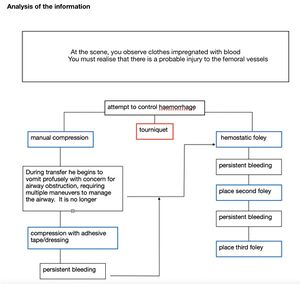
Here is a link to a video walking the learner through case 1[edit | edit source]
Case 2[edit | edit source]
Identifying Data: 21-year-old man
History: Patient found on a public street after multiple firearm injuries.
Vital Signs:
- HR 123 bpm
- BP 96/53
- RR 28
- GCS 15
- Shock Index 1.28
Physical Exam:
- Head: No injuries.
- Neck: 0.5cm orifice in zone 2 of the left neck with active pulsatile bleeding.
- Thorax: Symmetric ventilation. 0.5cm hole in the right infraclavicular region in the middle third of the clavicle, with an expanding hematoma.
- Abdomen/Pelvis: No injuries.
- Extremities: Left forearm with excoriation and projectile burn lesion measuring 10x2cm with minimal active bleeding. Distal pulses palpable and symmetric, capillary refill <3 seconds, intact distal motor and sensory function.
Analysis:
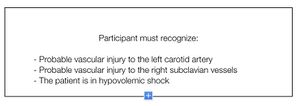
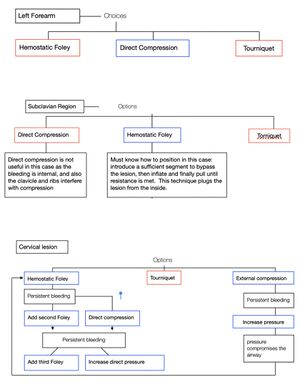
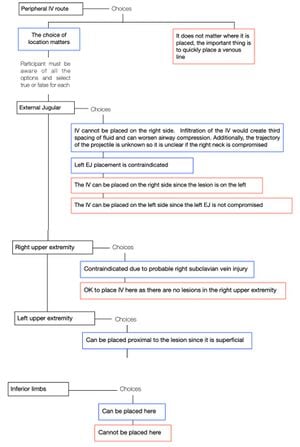
Here is a link to a video walking the learner through case 2.[edit | edit source]
Case 3[edit | edit source]
Identifying Data: 38-year-old woman
History: Victim of domestic violence who presents with multiple blunt traumatic injuries and a stab injury from a broken bottle to the left axillary region.
Vital Signs:
- HR 135 bpm
- BP 130/90
- RR 32
- GCS 15
- Shock Index 1.03
Focused Physical Exam:
- Head: Palpebral hematoma on the left, swelling and deformity of the nasal pyramid, no active bleeding.
- Neck: No evidence of injury.
- Thorax: Right scapular hematoma. Normal chest expansion, no crepitus or subcutaneous emphysema.
- Abdomen/Pelvis: No signs of trauma.
- Extremities: Irregular wound with loss of soft tissues in the left axillary region, approximately 11cm in diameter with non-pulsatile active bleeding. Distal pulses are symmetric, capillary refill <3 seconds, and no motor or sensory defects.
Analysis:
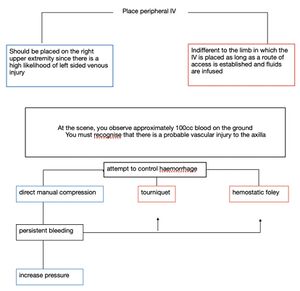
Here is a link to a video walking the learner through case 3.[edit | edit source]
Integration of Learning Modalities[edit | edit source]
The learner is expected to have prior basic lower and upper extremity anatomy and bleeding assessment knowledge to be able to correctly identify the bleeding and the next steps in the cases. We provide learning materials in the form of videos, texts, and diagrams regarding anatomy, and physiology both in Appropedia and inside the app to help with the knowledge acquisition phase. The learner should only attempt the clinical cases after completing the didactics review.The learners will gain critical thinking and decision-making skills that will teach them how to decide which technique to use based on the type of injury.
Skills Acquisition[edit | edit source]
After the completion of the gamified clinical cases and after the construction of the simulator the learner will practice hemorrhage control in the simulator. The repeated performance will construct the learning curve until the procedure can be done correctly.
The self-assessment is based on clinical case scenarios in the VR app. Skills acquisition is assessed via training on the physical simulator constructed by the learners. Once all exercises have been completed, learners will be able to evaluate themselves and measure their own pressure skills.
The learning experience and associated self-assessment are embedded in a learning environment in which gamification is employed to engage learners to complete both conceptual and practical activities. Results and immediate feedback for these activities are provided. To ensure that learners are practicing appropriate skills, the software-based simulation provides didactics and video-based instruction for the different hemorrhage control techniques.
Shortcomings of our Simulator Prototype[edit | edit source]
Given that our modules train people to respond to unanticipated situations in which patients are bleeding, it is difficult to assess learners in real time, and training on these emergency skills is done via simulator and on-the-job experience. We have taken on board feedback about blood pressure calibration from our first prototype module, and this is integrated into our current additional module prototypes to more realistically simulate physiologic pressures so that learners are better able to get a sense of how much pressure is required to stop hemorrhage. We have also incorporated construct validation into the simulator development process to ensure that the simulator works on its own to deliver skills training.
Applicability and clinical translation[edit | edit source]
The user learning will be transferred into clinical skills at the time that a first responder should apply pressure in a real life-threatening situation. Knowing how to use, inflate and position the catheter are the main objectives of the module, and learning by repetition to do it is the way that can be transferred to clinical situations.